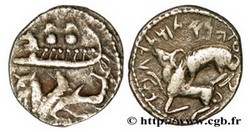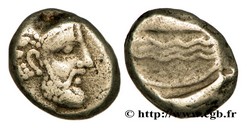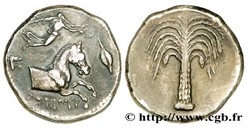Maps of the Antique
Mediterranean Sea
 Phoenicia Phoenicia
 Overview Overview
 Some dates Some dates
 Archaeological sites Archaeological sites
 Museums Museums
 Arts and ceramics Arts and ceramics
 Coinage Coinage
 Language and Writing Language and Writing

|
PHOENICIA : COINAGE
Phoenician merchants practised barter for a very long time and surprisingly, were not among the first to adopt the metal currency.
It will only break through when Darius I reorganizes its empire, and integrates Phoenicia in the fifth satrapy which includes Syria, Palestine and Cyprus, about 480 B.C.
Each city then minted its own silver and later bronze coins, at the effigy of the ruler, the protective god, or local patterns or symbols, like ships and cedars.
You may find coins from Sidon, Tyre, Byblos but also from Arados (Arwad) and Kition, Marathos, Berytos, Tripolis, etc.
In the same way, Carthage will take a long time before adopting coins. It’s mainly when it began fighting against the Greeks, in Sicily, about 410 B.C., that it decided to call upon coins… because mercenaries had to be paid!
The coins are based sometimes on Greek units (drachma), sometimes on Mesopotamian units (shekel) and show local symbols like horses, palm trees or the figure of the goddess Tanit.
Mint workshops operated in Palermo, Selinonte and Motye. Other coins appeared primarily to finance the armies at the time of the Punic Wars, with a decreasing value, along with the weakening of Carthage.

Byblos, ca. 330 B.C. silver, diametre 11mm |
BYBLOS
Byblos, known also as ' Gebal' , was located 20 km in the north of Beirut. For the IVth century B.C., we know the names of following kings: Elpaal, Azbaal, Adramelek and Ainel. They all adopt the same monetary typology. On the coins appears the murex, a very common shell in this area, which had brought richness to Tyre and was used to dye precious fabrics, giving them the crimson (purple) color.
Document CGB, www.cgb.fr |

Arados, ca. 400-350 B.C., silver, diametre 12mm |
ARADOS
Arados or Rouad (Arad) is thought to have been founded in the VIIIth century B.C. by colonists coming from Sidon. It is quoted in the Genesis (X, 18). The exceptional situation of the island, 0,4 km2, located three kilometers off the Syrian shore between Lattaquie and Tripolis made of it a strategic place of major importance. The city was surrounded with a defensive wall wich was also used as a dam against the floods. The port, facing towards the inland, was sheltered from storms. Arados was in turn tributary of the Egyptians, Assyrians, then Persians, but preserved local dynastes which were maintained until Alexander the Great came in. Straton, son of Gerostratos, king of Arados, submitted to the conqueror in 333 B.C., handed over his fleet and helped him at the siege of Tyr. He preserved its throne.
Document CGB, www.cgb.fr |

Sidon, ca. 370 B.C., silver, diametre 29,5mm |
SIDON
Sidon was with Tyre one of the main harbours on the phoenician shore, primarily a military port. The new coinage of Sidon started in 112-111 B.C. Pompey maintained its statute of free city, confirmed later by Mark Antony. The autonomous coinage stopped in 30/29 B.C
Document CGB, www.cgb.fr |

Marathos, ca. 97, copper, diametre 20,5mm |
MARATHOS
Marathos was an old Phoenician city, a traditional enemy of Arados. Whereas the maritime city had remained for a long time under seleucid influence, its rival had entered the lagide sphere. Arados recovered its independence in 259 B.C. After Antiochus III and the peace of Apamea, the Egyptian might declined in the area, especially under Ptolemy V (204-180 B.C.) who lost most of its possessions in Syria. Finally, Marathos was destroyed by its rival between 140 and 137 B.C., the time of the new civic coinage of Arados. After the destruction of Marathos, the victors founded a colony on the ruins of the city.
Document CGB, www.cgb.fr |

Tyre, ca. 33, silver, diametre 21,5mm |
TYR
Tyre, according to the tradition, seems to have been founded by colonists from Sidon, its great rival. Tyrian colonists founded Carthage in 814 B.C. Tyre was one of the main ports of Phoenicia and of the most important trade centers in the eastern Mediterranean Sea. Tyre refused to submit to Alexander the Great in 332 B.C. The siege of the city lasted for seven months, from January to August, under very tough conditions. Alexander was merciless and had all the population slaughtered or put into slavery. Tyre did not disappear, it was rebuilt. After Alexander’s death, the rulers changed frequently: Perdiccas in 321 B.C., Ptolemy the next year, then it was the turn of Antigonos the One-eyed in 314, and it returned in the hands of Ptolemey two years later. In 294 B.C., Tyre entered the seleucide sphere of influence. After 274 B.C., a new era seems to begin for Tyre. The city became autonomous after 126 B.C. and experienced a new political, economic and not least monetary development which continued under the Roman domination.
Document CGB, www.cgb.fr |

Carthage, ca. 410-380 B.C., silver, diametre 27mm |
CARTHAGE
Carthage was founded in 814 B.C., according to the tradition by colonists from Tyr. Virgil immortalized the deadly struggle which was to oppose Carthage and Rome in the Aeneid, introducing Aeneas, who wished to reach Italy, and the queen of Carthage Dido, who wanted to keep him near her. Before committing suicide after his departure, she would have pronounced the curse which was to threaten Rome and Carthage until the second was destroyed by the first in 146 B.C. Between the Vth and IVth century B.C., the most deadful enemies of the Carthaginians in the western Mediterranean Sea were the Greeks from southern Italy and Sicily. Gelo had already crushed the Carthaginian army at Himera in 480 B.C. and Agathocles, which was to take the title of king in 304 B.C., had invaded Africa in 310 B.C. Finally defeated in 307, it had to withdraw to Sicily and sign peace with the Carthaginians.
Document CGB, www.cgb.fr
|
|


















